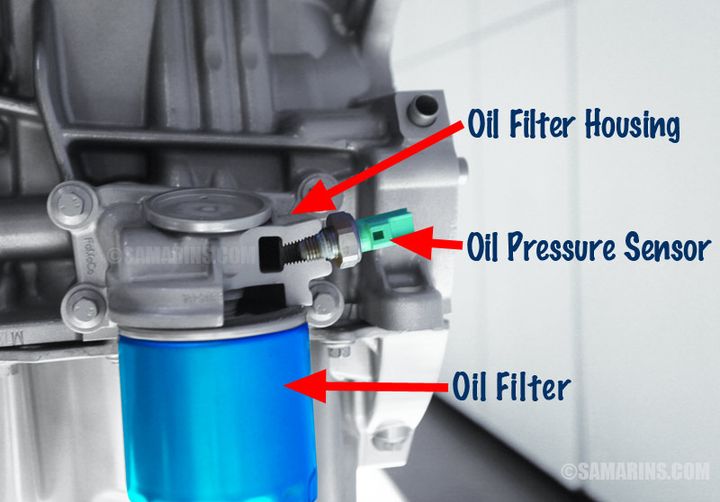


The oil pressure switch is a critical safety component in an engine that monitors the oil pressure levels and alerts the driver or operator when the pressure drops below a safe threshold. It plays a vital role in preventing engine damage due to low oil pressure, which can lead to catastrophic failure if left unaddressed.
An oil pressure switch is a mechanical or electrical device designed to detect changes in the engine's oil pressure. It acts as a safety mechanism, triggering a warning light or alarm when the oil pressure falls below a predetermined critical level. This alert prompts immediate action to address the underlying issue and prevent potential engine damage.
Proper lubrication is essential for the smooth operation and longevity of an engine. The oil pressure switch plays a crucial role in ensuring that the engine's moving components are adequately lubricated by monitoring the oil pressure levels. A well-functioning oil pressure switch can help avoid costly repairs or replacements resulting from insufficient lubrication.
The oil pressure switch is a critical safety component that serves as the first line of defense against low oil pressure conditions. By continuously monitoring the oil pressure, it provides real-time feedback to the driver or operator, allowing them to take prompt action before severe damage occurs.

An oil pressure switch typically consists of a diaphragm or movable element connected to a set of electrical contacts. When the engine is running, the oil pump circulates oil through the engine, creating pressure. This pressure is sensed by the oil pressure switch, which is connected to the engine's oil pressure system.
| Component | Function |
|---|---|
| Diaphragm or movable element | Senses oil pressure changes |
| Electrical contacts | Open or close circuit based on pressure |
| Oil pump | Circulates oil, creating pressure |
| Oil pressure system | Connects switch to engine oil pressure |
The oil pressure switch has a predetermined critical pressure value, usually between 0.25 and 0.75 bar (3.5 – 11 psi), depending on the engine type. If the oil pressure falls below this critical value, the diaphragm or movable element inside the switch moves, causing the electrical contacts to either open or close, depending on the switch design.
| Switch Type | Initial State | Low Pressure State |
|---|---|---|
| Normally Open Contacts | Contacts open | Contacts close, activating warning |
| Normally Closed Contacts | Contacts closed | Contacts open, activating warning |
The critical pressure value at which the oil pressure switch activates is determined by the engine's design and specifications. This value ensures that the warning is triggered before the oil pressure drops to a level that could cause significant damage to the engine components.
Oil pressure switches are typically located in one of the following areas:
Engine block
Oil filter housing
Engine head
The exact location may vary depending on the specific engine design and vehicle make and model. Proper installation is crucial to ensure accurate oil pressure monitoring and prevent leaks.
| Installation Tip | Description |
|---|---|
| Follow manufacturer instructions | Provides guidance on location, torque specs, and special considerations |
| Apply correct torque | Prevents leaks and ensures proper sealing |
| Use sealants or gaskets | Helps prevent oil leaks during installation |
The primary function of an oil pressure switch is to prevent engine damage caused by low oil pressure. Insufficient oil pressure can lead to increased friction, excessive wear, and potentially catastrophic engine failure if left unaddressed.
When the oil pressure switch detects a drop in oil pressure below the critical level, it activates a warning light or alarm on the vehicle's dashboard or control panel. This alert prompts the driver or operator to take immediate action, such as stopping the engine and investigating the cause of the low oil pressure.
In addition to its primary role, some oil pressure switches may have additional functions:
Controlling an oil pressure gauge or indicator, providing real-time feedback on oil pressure levels.
Integrated into an automatic engine shutdown system, automatically shutting down the engine in severe cases of low oil pressure to prevent further damage.
If the oil pressure warning light remains illuminated or fails to turn on when the engine is running, it may indicate a faulty oil pressure switch. Diagnosing the issue typically involves the following steps:

Check the electrical connections and wiring for proper fit or damage.
Inspect the switch housing for leaks or contamination.
Use a multimeter to test the continuity between the switch contacts with the engine off (should be closed for normally closed switches) and with the engine running (should be open for normally closed switches).
Common issues that can cause an oil pressure switch to fail include:
| Issue | Description |
|---|---|
| Clogged inlet bores | Contaminants or debris accumulate, preventing accurate pressure sensing |
| Contact failure | Electrical contacts wear out or become corroded |
| Internal short-circuits | Manufacturing defects or damage cause malfunctions or inaccurate readings |
| Measuring element damage | Diaphragm or movable element becomes damaged or stuck |
Replacing the switch may be necessary if it is found to be defective.
Regular inspection and maintenance of the oil pressure switch are recommended to ensure its proper functioning. During routine oil changes or engine servicing, it is advisable to check the switch for any signs of damage, leaks, or contamination.
The oil pressure switch should be replaced in the following situations:
Faulty or failed switch (identified during diagnostic testing)
End of service life (as recommended by the manufacturer based on mileage or time interval)
When replacing the oil pressure switch, it is crucial to select the correct replacement switch for the specific vehicle or application. Ensure compatibility with the make, model, and year of the vehicle or engine, and consult the manufacturer's recommendations or repair manuals to select the correct replacement switch.
The oil pressure switch plays a critical role in monitoring and alerting the driver or operator to low oil pressure conditions, which can prevent costly engine damage and ensure safe operation. Regular maintenance, proper installation, and timely replacement of the oil pressure switch are essential for maintaining the health and longevity of any engine.
By covering these aspects in detail, supported by the information from the provided search results, this comprehensive guide aims to address the query "what does the oil pressure switch do" effectively, providing valuable insights for automotive enthusiasts and professionals alike.
The purpose of an oil pressure switch is to detect low oil pressure in an engine and activate a warning light or alarm. It helps prevent engine damage by alerting the operator to address the issue.
An oil pressure switch contains a diaphragm or movable element that senses oil pressure changes and opens or closes electrical contacts accordingly.
The oil pressure switch is typically located in the engine block, oil filter housing, or engine head, depending on the specific engine design.
If the oil pressure switch fails, the warning light may remain illuminated or fail to turn on, preventing the operator from being alerted to low oil pressure conditions.
You can test an oil pressure switch by checking the continuity between its contacts with a multimeter, both with the engine off and running.
Common causes include clogged inlet bores, contact failure, internal short-circuits, and damaged measuring elements.
An oil pressure switch should be replaced if it is found to be faulty during diagnostic testing or if it has reached the end of its service life.
Yes, it is crucial to select the correct replacement oil pressure switch that is compatible with the specific vehicle or engine make, model, and year.
In some cases, an oil pressure switch may be integrated into a system that controls an oil pressure gauge or indicator, providing real-time feedback on oil pressure levels.
An oil pressure switch is a simple on/off device that activates a warning, while an oil pressure sensor provides continuous feedback on the oil pressure levels.

Sarah isn't your average gearhead. With a double major in Mechanical Engineering and Automotive Technology, she dived straight into the world of car repair. After 15 years of turning wrenches at dealerships and independent shops, Sarah joined MICDOT to share her expertise and passion for making cars run like new. Her in-depth knowledge and knack for explaining complex issues in simple terms make her a valuable asset to our team.












